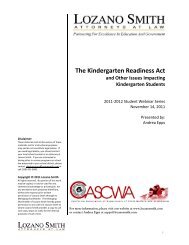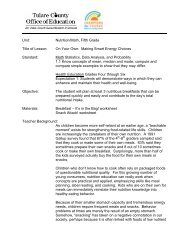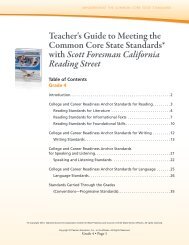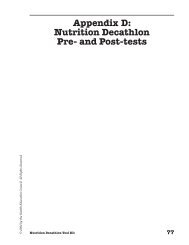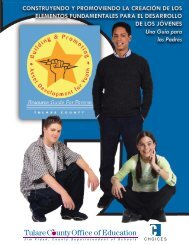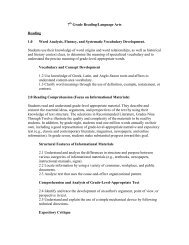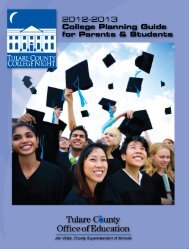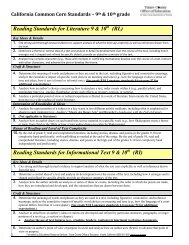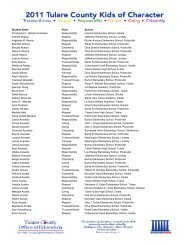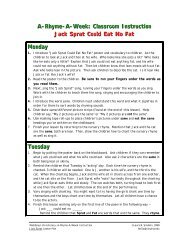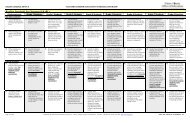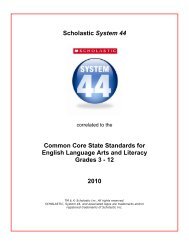CCCS K-5 ELA Continuum - Tulare County Office of Education
CCCS K-5 ELA Continuum - Tulare County Office of Education
CCCS K-5 ELA Continuum - Tulare County Office of Education
- No tags were found...
Create successful ePaper yourself
Turn your PDF publications into a flip-book with our unique Google optimized e-Paper software.
ENGLISH LANGUAGE ARTS K‐5 “CALIFORNIA COMMON CORE CONTENT STANDARDS CONTINUUM”Reading Standards for Informational Text K-5 (RI)Kindergartners: Grade 1 Students Grade 2 Students Grade 3 Students Grade 4 Students Grade 5 StudentsKey Ideas & Details1. With prompting and support, ask andanswer questions about key details in atext.2. With prompting and support, identify themain topic and retell key details <strong>of</strong> a text.3. With prompting and support, describe theconnection between two individuals,events, ideas, or pieces <strong>of</strong> information in atext.Craft & Structure4. With prompting and support, ask andanswer questions about unknown words ina text. (See grade K Language standards4-6 for additional expectations.)5. Identify the front cover, back cover, andtitle page <strong>of</strong> a book.6. Name the author and illustrator <strong>of</strong> a textand define the role <strong>of</strong> each in presentingthe ideas or information in a text.Integration <strong>of</strong> Knowledge & Ideas7. With prompting and support, describe therelationship between illustrations and thetext in which they appear (e.g., whatperson, place, thing, or idea in the text anillustration depicts).8. With prompting and support, identify thereasons an author gives to support points ina text.9. With prompting and support, identify basicsimilarities in and differences between twotexts on the same topic (e.g., inillustrations, descriptions, or procedures).1. Ask and answer questions about keydetails in a text.2. Identify the main topic, and retell keydetails in a text.3. Describe the connection between twoindividuals, events, ideas, or pieces <strong>of</strong>information in a text.4. Ask and answer questions to helpdetermine or clarify the meaning <strong>of</strong> wordsand phrases in a text. (See grade 1Language standards 4-6 for additionalexpectations.)5. Know and use various text structures(e.g., sequence) and text features (e.g.,headings, tables <strong>of</strong> contents, glossaries,electronic menus, icons) to locate key factsor information in a text.6. Distinguish between information providedby pictures or other illustrations andinformation provided by the words in atext.7. Use the illustrations and details in a text todescribe its key ideas.8. Identify the reasons an author gives tosupport points in a text.9. Identify basic similarities in anddifferences between two texts on the sametopic (e.g., in illustrations, descriptions, orprocedures).1. Ask and answer such questions as who,what, where, when, why, and how todemonstrate understanding <strong>of</strong> key detailsin a text.2. Identify the main topic <strong>of</strong> a multiparagraphtext as well as the focus <strong>of</strong> specificparagraphs within the text.3. Describe the connection between a series<strong>of</strong> historical events, scientific ideas orconcepts, or steps in technical proceduresin a text.4. Determine the meanings <strong>of</strong> words andphrases in a text relevant to a grade 2 topicor subject area.(See grade 2 Languagestandards 4-6 for additionalexpectations.)5. Know and use various text features (e.g.,captions, bold print, subheadings,glossaries, indexes, electronic menus,icons) to locate key facts or information ina text efficiently.6. Identify the main purpose <strong>of</strong> a text,including what the author wants to answer,explain, or describe.7. Explain how specific images (e.g., adiagram showing how a machine works)contribute to and clarify a text.8. Describe how reasons support specificpoints the author makes in a text.9. Compare and contrast the most importantpoints presented by two texts on the sametopic.1. Ask and answer questions to demonstrateunderstanding <strong>of</strong> a text, referring explicitlyto the text as the basis for the answers.2. Determine the main idea <strong>of</strong> a text; recountthe key details and explain how theysupport the main idea.3. Describe the relationship between a series<strong>of</strong> historical events, scientific ideas orconcepts, or steps in technical proceduresin a text, using language that pertains totime, sequence, and cause/effect.4. Determine the meaning <strong>of</strong> generalacademic and domain-specific words andphrases in a text relevant to a grade 3 topicor subject area.(See grade 3 Languagestandards 4-6 for additionalexpectations.)5. Use text features and search tools (e.g.,key words, sidebars, hyperlinks) to locateinformation relevant to a given topicefficiently.6. Distinguish their own point <strong>of</strong> view fromthat <strong>of</strong> the author <strong>of</strong> a text7. Use information gained from illustrations(e.g., maps, photographs) and the words ina text to demonstrate understanding <strong>of</strong> thetext (e.g., where, when, why, and how keyevents occur).8. Describe the logical connection betweenparticular sentences and paragraphs in atext (e.g., comparison, cause/effect,first/second/third in a sequence).9. Compare and contrast the most importantpoints and key details presented in twotexts on the same topic.1. Refer to details and examples in a textwhen explaining what the text saysexplicitly and when drawing inferencesfrom the text.2. Determine the main idea <strong>of</strong> a text andexplain how it is supported by key details;summarize the text.3. Explain events, procedures, ideas, orconcepts in a historical, scientific, ortechnical text, including what happenedand why, based on specific information inthe text.4. Determine the meaning <strong>of</strong> generalacademic and domain-specific words orphrases in a text relevant to a grade 4 topicor subject area.(See grade 4 Languagestandards 4-6 for additionalexpectations.)5. Describe the overall structure (e.g.,chronology, comparison, cause/effect,problem/solution) <strong>of</strong> events, ideas,concepts, or information in a text or part <strong>of</strong>a text.6. Compare and contrast a firsthand andsecondhand account <strong>of</strong> the same event ortopic; describe the differences in focus andthe information provided.7. Interpret information presented visually,orally, or quantitatively (e.g., in charts,graphs, diagrams, time lines, animations,or interactive elements on Web pages) andexplain how the information contributes toan understanding <strong>of</strong> the text in which itappears.8. Explain how an author uses reasons andevidence to support particular points in atext.9. Integrate information from two texts on thesame topic in order to write or speak aboutthe subject knowledgeably.1. Quote accurately from a text whenexplaining what the text says explicitly andwhen drawing inferences from the text.2. Determine two or more main ideas andhow they are supported by key details;summarize the text.3. Explain the relationships or interactionsbetween two or more individuals, events,ideas, or concepts in a historical, scientific,or technical text based on specificinformation in the text.4. Determine the meaning <strong>of</strong> generalacademic and domain-specific words andphrases in a text relevant to a grade 5 topicor subject area. (See grade 5 Languagestandards 4-6 for additionalexpectations.)5. Compare and contrast the overall structure(e.g., chronology, comparison,cause/effect, problem/solution) <strong>of</strong> events,ideas, concepts, or information in two ormore texts.6. Analyze multiple accounts <strong>of</strong> the sameevent or topic, noting importantsimilarities and differences in the point <strong>of</strong>view they represent.7. Draw on information from multiple printor digital sources, demonstrating theability to locate an answer to a questionquickly or to solve a problem efficiently.8. Explain how an author uses reasons andevidence to support particular points in atext, identifying which reasons andevidence support which point(s).9. Integrate information from several texts onthe same topic in order to write or speakabout the subject knowledgeably.Range <strong>of</strong> Reading and Level <strong>of</strong> Text Complexity10. Actively engage in group reading activitieswith purpose and understanding.a. Activate prior knowledge related tothe information and events in texts.b. Use illustrations and context tomake predictions about text.10. With prompting and support, readinformational texts appropriately complexfor grade 1.a. Activate prior knowledge related tothe information and events in texts.b. Confirm predictions about whatwill happen next in text.10. By the end <strong>of</strong> the year, read andcomprehend informational texts, includinghistory/social studies, science, andtechnical texts, in the grades 2-3 textcomplexity band pr<strong>of</strong>iciently, withscaffolding as needed at the high end <strong>of</strong>the range.10. By the end <strong>of</strong> the year, read andcomprehend informational texts, includinghistory/social studies, science, andtechnical texts, at the high end <strong>of</strong> thegrades 2-3 text complexity bandindependently and pr<strong>of</strong>iciently.10. By the end <strong>of</strong> the year, read andcomprehend informational texts, includinghistory/social studies, science, andtechnical texts, in the grades 4-5 textcomplexity band pr<strong>of</strong>iciently, withscaffolding as needed at the high end <strong>of</strong> therange.10. By the end <strong>of</strong> the year, read andcomprehend informational texts includinghistory/social studies, science, andtechnical texts, at the high end <strong>of</strong> thegrades 4-5 text complexity bandindependently and pr<strong>of</strong>iciently.Page 2 <strong>of</strong> 15 Formatted by <strong>Education</strong>al Resource Services, <strong>Tulare</strong> <strong>County</strong> <strong>Office</strong> <strong>of</strong> <strong>Education</strong>, Visalia, California (559) 651‐3031 www.tcoe.org/ers/ *BOLD INDICATES CALIFORNIA’S 15%



